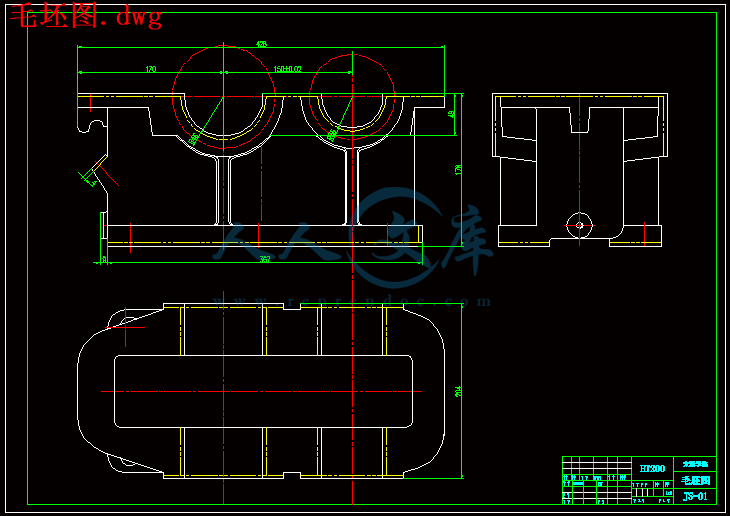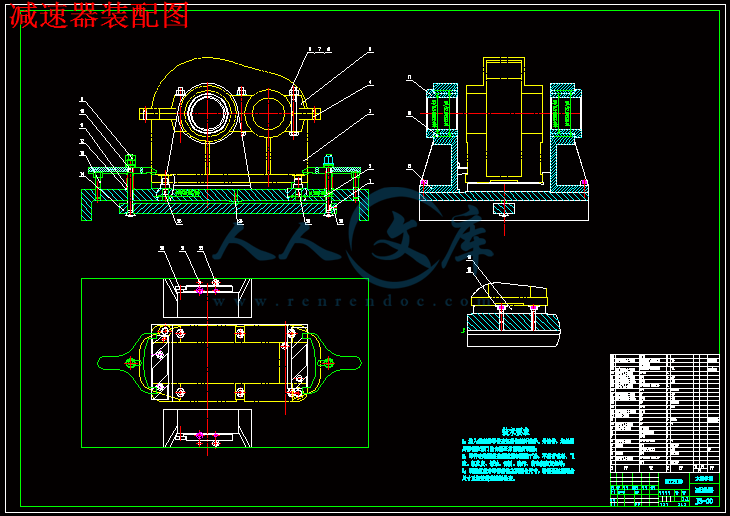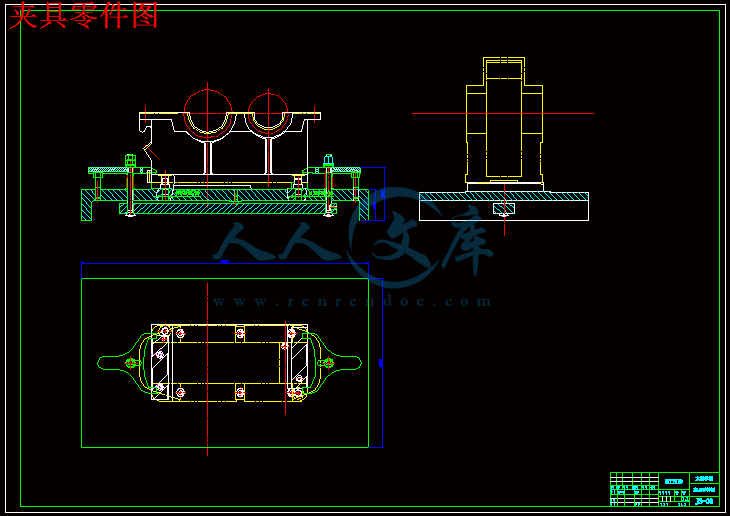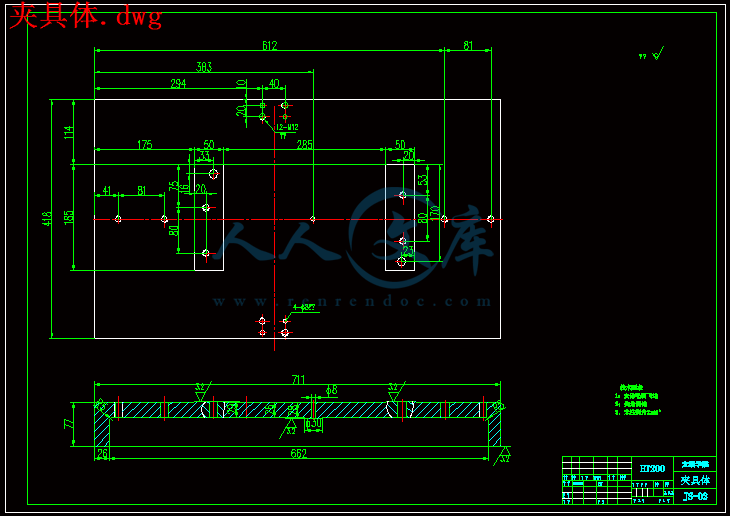摘 要
本次设计内容涉及了机械制造工艺及机床夹具设计、金属切削机床、公差配合与测量等多方面的知识。
减速箱体加工工艺规程及其镗Φ100孔的夹具设计是包括零件加工的工艺设计、工序设计以及专用夹具的设计三部分。在工艺设计中要首先对零件进行分析,了解零件的工艺再设计出毛坯的结构,并选择好零件的加工基准,设计出零件的工艺路线;接着对零件各个工步的工序进行尺寸计算,关键是决定出各个工序的工艺装备及切削用量;然后进行专用夹具的设计,选择设计出夹具的各个组成部件,如定位元件、夹紧元件、引导元件、夹具体与机床的连接部件以及其它部件;计算出夹具定位时产生的定位误差,分析夹具结构的合理性与不足之处,并在以后设计中注意改进。
关键词:工艺,工序 切削用量 夹紧 定位 误差
Abstract
This design content has involved the machine manufacture craft and the engine bed jig design, the metal-cutting machine tool, the common difference coordination and the survey and so on the various knowledge.
The reduction gear box body components technological process and its the processing ¢ 140 hole jig design is includes the components processing the technological design, the working procedure design as well as the unit clamp design three parts. Must first carry on the analysis in the technological design to the components, understood the components the craft redesigns the semi finished materials the structure, and chooses the good components the processing datum, designs the components the craft route; After that is carrying on the size computation to a components each labor step of working procedure, the key is decides each working procedure the craft equipment and the cutting specifications; Then carries on the unit clamp the design, the choice designs the jig each composition part, like locates the part, clamps the part, guides the part, to clamp concrete and the engine bed connection part as well as other parts; Position error which calculates the jig locates when produces, analyzes the jig structure the rationality and the deficiency, and will design in later pays attention to the improvement.
Keywords: The craft; the working procedure; the cutting specifications; clamp; the localization; the error.
目 录
摘 要III
AbstractIV
1 绪论1
1.1本课题的研究内容和意义1
1.2国内外的发展概况1
1.3本课题应达到的要求2
2 工艺设计3
2.1 零件的分析3
2.1.1 零件的作用3
2.1.2 零件的工艺分析4
2.2 毛坯的选择与设计及基准的确定5
2.2.1 确定毛坯制造形式5
2.2.2 基准的选择5
2.3 加工顺序的安排6
2.4 工艺规程的设计6
2.4.1 制定工艺路线6
2.4.2 工艺方案的比较与分析7
3 工序设计9
3.1 工序尺寸与毛坯尺寸加工余量的确定9
3.2 设备和工艺装备的选择11
3.3 确定切削用量及时间定额12
4 夹具设计21
4.1 夹具的设计21
4.2 夹紧装置的组成及设计要求21
4.2.1 动力源21
4.2.2 中间传力机构22
4.2.3 夹紧元件22
4.3 切削力与夹紧力的计算22
4.3.1 切削力的计算22
4.3.2 夹紧力的确定23
4.4 定位误差的分析与计算24
4.5 夹具设计与操作的简要说明25
4.5.1 夹具体方式的确定25
4.5.2 夹具的精度要求25
4.5.3 夹具使用注意事项、保养及维护25
4.6 关于铣箱体与箱盖接合面的夹具设计26
5 结论与展望27
5.1 结论27
5.2 不足之处及未来展望28
致 谢29
参 考 文 献30
1 绪论
1.1 本课题的研究内容和意义
减速器是原动机和工作机之间的独立的闭式传动装置,用来降低转速和增大转矩。无须联轴器和适配器,结构紧凑。负载分布在行星齿轮上,因而承载能力比一般斜齿轮减速机高。满足小空间高扭矩输出的需要。齿轮减速器广泛应用于大型矿山,钢铁,化工,港口,环保等领域。
减速器箱体在整个减速器总成中起支撑和连接的作用,它把各个零件连接起来,支撑传动轴,保证各穿动机的正确安装,是传动零件的基座,应具有足够的强度和刚度。因此变速器箱体的加工质量的优劣,将直接影响到轴和齿轮等零件位置的准确性,也为将会影响江苏器的寿命和性能。
结构特点
变速器箱体是典型的箱体零件,其结构和形状复杂,壁薄,外部为了增加有很多加强筋。有精度较高的多个平面、轴承孔,螺孔等需要加工,应为刚度较差,切屑受热大,易产生震动和变形。
零件装配
箱体通常用灰铸铁制造,对于重载或有冲击载荷的减速器也可以采用铸钢箱体。灰铸铁具有河很好的铸造性能和减振性能。为了便于轴系部件的安装和拆卸,箱体制成沿着轴心线水平剖分式。上箱体和下箱体是用楼栓联接成一体。轴承座的联接楼栓应尽量靠近轴承座孔,而轴承座旁的凸台,应具有足够的承托面,以便放置联接楼栓,并保证旋紧楼栓时需要的扳手空间。为保证箱体具有足够的刚度,在轴承孔的附近加支撑肋。为保证减速器安置在基础上的稳定性并尽可能减少箱体底座平面的机械加工面积,箱体底座一般不采用完整的平面。






 川公网安备: 51019002004831号
川公网安备: 51019002004831号